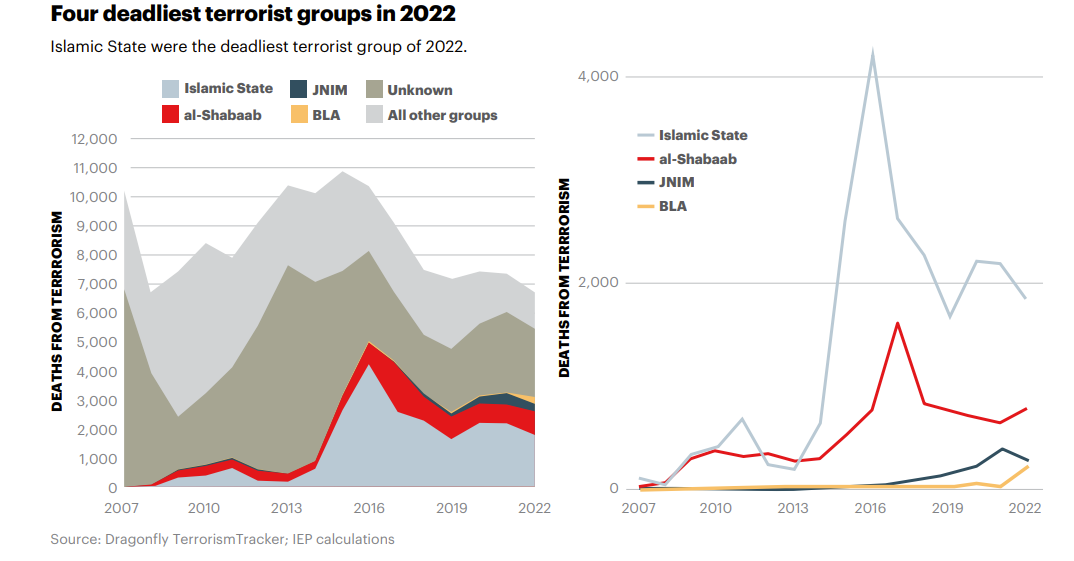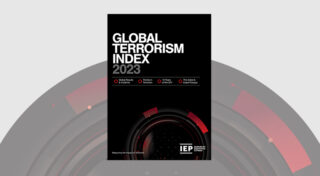In 2012, the four terrorist groups that claimed 47% of deaths in 2022 accounted for less than 7% of all terrorism deaths. An increase of 40% signifies a large-scale, global shift in terrorism over the last decade. Although the number of deaths from terrorism has declined, terrorist attacks were increasingly lethal in 2022, killing on average 1.7 people per attack. An additional trend in terrorist activity has been the increased tendency of terrorist groups to refrain from claiming responsibility for attacks, which has made it challenging to track the activity of terrorist groups.
Following years of insurrection, the Taliban captured Afghanistan’s capital Kabul, on the 15th of August 2021. This led to the Islamic Emirate of Afghanistan being reinstated as the Islamic Republic of Afghanistan was overthrown. As a result, the Taliban are now the state actors for much of Afghanistan and their attacks fall outside of the scope of the GTI’s terrorism definition. Acts committed by the Taliban are included in other measures such as the Political Terror Scale, which is contained in the GPI.

IS, along with its affiliate groups, were the deadliest of terrorist groups in 2022. The group has steadily maintained a rate of about 2,000 deaths per year, this has occurred since 2019. The group formed as an Al-Qaeda affiliate in Iraq and Syria in 1999, primarily aligning with a global jihadist ideology, promoting violence against anyone who chooses not to align with their ideology. IS are enhancing their focus on insurgency outside of the Levant, through affiliated terrorist activities in the Sahel region of sub-Saharan Africa.
Recent Islamic-State activity
The country most affected by IS activity last year was Iraq, where 183 attacks were recorded. Syria and Afghanistan were also primary targets of IS terrorism. The deadliest form of IS terrorism of 2022 was a ten-day attack on Syria’s Al-Sina Prison, which took place in January. At least 154 Syrian Democratic forces personnel were killed and 120 wounded.
Suicide bombings are still the deadliest form of IS activity, despite the fact that this form of attack halved in occurrence in 2022, with 13 attacks and 141 deaths. This is the lowest number of Suicide bombings attributed to IS since 2014. Explosive attacks increased in lethality, with deaths increasing to 721 for 2022.
IS’s most common target continues to be the military, a target which represented 43 per cent of all IS attacks in 2022. Despite this, civilians faced the greatest number of causalities, as 690 civilian deaths were recorded in 2022.
Al-Shabaab is a Salafist militant group active in East Africa, affiliated with Al-Qaeda, Al-Shabaab pursues Islamist statehood aspirations in Somalia and was estimated to have between 7,000 and 9,000 fighters in 2019. Al-Shabaab emerged as a global threat following several deadly attacks on areas around the capital city of Mogadishu and neighbouring countries of Kenya, Ethiopia and Uganda in the 2000s
Recent Al-Shabaab activity
Terrorism deaths attributed to by Al-Shabaab increased for the first time in six years. 97% of the 1784 deaths caused by Al-Shabaab in 2022, occurred in Somalia. Reportedly, al-Shabaab are attempting to expose Ethiopia’s internal instability in attempt to increase its control of the region, following the Tigray war.
Primarily driven by increased activity in Mogadishu, deaths caused by al-Shabaab in Somalia increased by 23%. Terrorist activity in Mogadishu remains a priority for al-Shabaab and the group’s deadliest attack for 2022 took place here as two car bombs were placed outside the education ministry’s building, killing around 120 people. Almost 63% of deaths attributed to Al-Shabaab in 2022 were the result of bombings, followed by armed assaults, accounting for 32% of deaths. Al-Shabaab’s attacks were primarily aimed at the military, followed by civilians. Overall, the GTI recorded that al-Shabaab’s civilian deaths increased by a quarter between 2021 and 2022. This is the first increase in civilian deaths in three years.
The BLA are an ethno-nationalist group, motivated by the endeavour to achieve greater regional autonomy of the province of Balochistan in Pakistan’s south-west, bordering Afghanistan and Iran. The group initiated as a response to increasing resentment in Balochistan over perceived extortion by the government, of the region’s natural resources and discrimination against the Balochi people.
Recent BLA activity
Current terrorism-related deaths are now at their highest for the last two decades for BLA, with 233 deaths recorded in 2022. In comparison to the 26 deaths recorded in 2021, this represents a ninefold increase. BLA’s lethality rate also increased to its highest level as their attacks killed 7.7 people each time, compared to 1.5 people per attack in 2021.
BLA’s deadliest attack of 2022 occurred when gunmen attacked two separate security posts for the Frontier Corps in Pakistan, in February 2022. BLA claimed they were responsible for the attacks which killed 195 soldiers, the deadliest attacks in Pakistan last year. BLA’s tactics for attacks have predominantly relied on explosives, followed by grenade attacks at 33%. In 2022, BLA initiated 14 explosive attacks, with a lethality rate of 15 deaths per attack.
JNIM’s formation occurred in 2017 in the Sahel region of sub-Saharan Africa as a coalition of Salafi-jihadist insurgent groups consisting of Ansar Dine, the Macina Liberation Front, Al-Mourabitoun and the Saharan branch of Al-Qaeda in the Islamic Maghreb. JNIM’s expansion has seen acts of violence across West Africa, as the group claims its aims are to incite Muslims to rise against oppression, expel occupying powers from the Sahel region and implement Islamic governance.
Recent JNIM activity
JNIM claimed 279 deaths in 2022, representing a 28% decrease since 2021. Around 48% of the deaths caused by JNIM occurred in Burkina Faso, and 43% in Mali. JNIM has since initiated attacks in Benin and Togo as part of its campaign to expand its control outside of the Sahel.
Most of the attacks carried out in Mali were directed at the military, yet civilians suffered the greatest. JNIM’s attacks in Burkina Faso accounted for 48% of the region’s total death toll in 2022. JNIM’s deadliest attack of 2022 took place in Burkina Faso’s Sahel province, as 27 soldiers and ten civilians were killed by gunmen. The lethality rate from explosive attacks increased for the first time in four years for JNIM, whilst their total number of attacks rose slightly in 2022, from 21 to 27. The group also targeted far less police and prisons in 2022 with casualties for this group falling from 72 to just seven.
Produced by the Institute for Economics & Peace (IEP), the Global Terrorism Index (GTI) is a comprehensive study that assesses the impact of terrorism on 163 countries, covering 99.7% of the world’s population. The report aims to analyze global trends in terrorism, offering valuable insights for informed policy responses to counter-terrorism efforts worldwide.

Download the Global Terrorism Index 2023.
Global Terrorism Index 2023